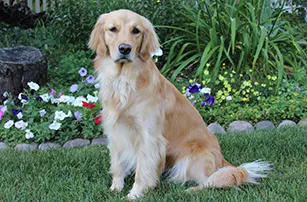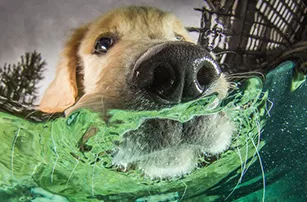We couldn’t do this work without the veterinarians, owners and dogs enrolled in the study, and without the support of individual donors and companies like Coastal Pet Products. Thanks to all who are making the Golden Retriever Lifetime Study a going success.
When Morris Animal Foundation launched its Golden Retriever Lifetime Study in 2012, the organization was taking a bold step into uncharted territory. Using the groundbreaking Framingham human heart study as a model, the Foundation design a similar study focused on canine cancer. Seven years later, the study is going strong and researchers are looking forward to the first published papers coming out later this year looking at early health outcomes.
The idea for the study was the result of a fortuitous conversation in 2008 between three key individuals: Bette Morris, long-time Foundation trustee and respected scientist; Dr. Rod Page, Professor and Director of the Flint Animal Cancer Center at Colorado State University; and Dr. Patty Olson, CEO and President of Morris Animal Foundation at the time.

Amber, Hero #2715
Cancer was the topic of conversation. It remains the major cause of death in older dogs and, although great strides have been made in treating cancer, the conversation turned to identifying risk factors for the disease. If we could understand what leads to a higher risk for cancer, steps could be taken to remove these risks, ultimately preventing cancer from developing.
But how to do this? The best way to identify risk factors would be to follow a group of dogs prone to cancer throughout their entire lives, documenting everything: their diet, their environment and their activity. It also would mean that biologic samples – urine, blood, hair, nails and feces – would need to be routinely collected and stored.
The underlying genetic background of the study group would have to be well-documented. Finally, enough dogs and dedicated owners would need to be recruited and retained for more than a decade. It would be a massive undertaking – no one in veterinary medicine had ever attempted this type of study before! The Foundation accepted the challenge and moved forward with planning and fundraising. The golden retriever was selected for the study because of its high incidence of cancer, and because the popularity of the breed meant there would be lots of dogs that would qualify to participate. The first dogs were enrolled in June 2012.
Although daunting at first, the study has been a tremendous success. We enrolled our 3000th dog in March of 2015. Seven years in, we have a staggering 85% compliance rate among our study participants with almost 97% of dogs still enrolled, statistics rivaling the best seen in human medicine. Almost half a million biologic specimens have been collected and banked. We have thousands of questionnaires filled out carefully by owners and veterinarians documenting everything from diet to environment.

Butters, Hero #2592
Once the study was underway, we turned to the next challenge – using our samples and data to help researchers answer important questions about canine cancer and other health issues. We have several studies in progress. Current studies include a look at the gut bacteria differences between lean and obese dogs, another is looking at the effects of inbreeding on litter size and adult stature and yet another is looking at bloodwork changes over time. These studies are just winding up and we’re excited to see what our researchers find!
Closer to home, our staff epidemiologist, Dr. Missy Simpson, has been starting to crunch the data and looking first at the effect of early spay/neuter on health outcomes. Her particular area of interest is the interaction of timing of spay/neuter and the development of obesity. Dr. Simpson’s current project is looking at timing of spay/neuter and non-traumatic orthopedic injury.
Unfortunately, as our cohort ages we’re seeing more cancer development. We’ve lost 60 dogs to cancer out of 131 total deaths – that’s 45% of our total losses. Lymphoma is the most common cancer diagnosed in our cohort, followed by hemangiosarcoma, which accounts for 10% of our deaths. We need at least 500 cancer diagnoses for us to make valid associations between an environmental risk factor and cancer, and we anticipate that it will take approximately 5 more years to reach this goal. It’s a long time to wait but the information we’ll get from watching this large group of dogs through their lifetime will provide invaluable information that will be used to improve the lives of dogs everywhere.

